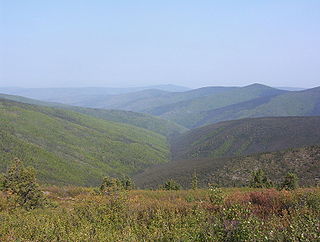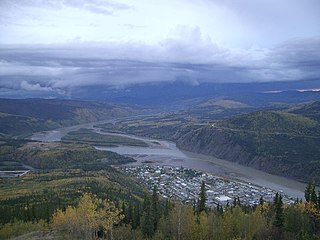
The Klondike is a region of the territory of Yukon, in northwestern Canada. It lies around the Klondike River, a small river that enters the Yukon River from the east at Dawson City. The area is merely an informal geographic region, and has no function to the territory as any kind of administrative region. It is located in the traditional territory of the Tr’ondëk Hwëch’in First Nation.

Yukon is the smallest and westernmost of Canada's three territories. It is the third-least populated province or territory in Canada, with a population of 45,148 as of 2023. However, Whitehorse, the territorial capital, is the largest settlement in any of the three territories.

The Klondike Gold Rush was a migration by an estimated 100,000 prospectors to the Klondike region of Yukon, in north-western Canada, between 1896 and 1899. Gold was discovered there by local miners on August 16, 1896; when news reached Seattle and San Francisco the following year, it triggered a stampede of prospectors. Some became wealthy, but the majority went in vain. It has been immortalized in films, literature, and photographs.

Dawson City, officially the City of Dawson, is a city in the Canadian territory of Yukon. It is inseparably linked to the Klondike Gold Rush (1896–1899). Its population was 1,577 as of the 2021 census, making it the second-largest city in Yukon.

Klondike Gold Rush National Historical Park is a national historical park operated by the National Park Service that seeks to commemorate the Klondike Gold Rush of the late 1890s. Though the gold fields that were the ultimate goal of the stampeders lay in the Yukon Territory, the park comprises staging areas for the trek there and the routes leading in its direction. There are four units, including three in Municipality of Skagway Borough, Alaska and a fourth in the Pioneer Square National Historic District in Seattle, Washington.
Moosehide was an Indian reserve of the Tr'ondëk Hwëch'in First Nation or Dawson band in the Canadian territory of Yukon between about 1906 and the early 1960s. Located near a tradiitonal salmon-fishing ground, Moosehide was first occupied about 9,000 years ago. Starting the mid-1800s, and accelerating the Klondike Gold Rush, European settles arrived in the area and began to settle in and around Dawson City. The Tr'ondëk Hwëch'in were forced to relocate, first just to the south of Dawson and in 1897 to Moosehide. The St. Barnabas Church was built by the Anglican Church of Canada in 1908. A cemetery with about 200 burials is located behind the church. Moosehide is also the site of the cabin of Chief Isaac, who was the leader of the Tr'ondëk Hwëch'in during the Klondike Gold Rush. At the time of the 1911 census, 'Moose Hide' was a village, with a recorded population of 125.

The Trʼondëk Hwëchʼin is a First Nation band government located in the Canadian territory, Yukon. Its main population centre is Dawson City, Yukon.

Jefferson Randolph "Soapy" Smith II was an American con artist and gangster in the American frontier.

Forty Mile is best known as the oldest town in Canada’s Yukon. It was established in 1886 at the confluence of the Yukon and Fortymile rivers by prospectors and fortune hunters in search of gold. Largely abandoned during the nearby Klondike Gold Rush, the town site continued to be used by Tr’ondëk Hwëch’in. It is currently a historic site that is co-owned and co-managed by Tr'ondëk Hwëch'in and the Government of Yukon. Ch’ëdähdëk became part of the Tr’ondëk-Klondike UNESCO World Heritage Site in 2023, recording of the transformation of the landscape and the Indigenous adaptation to European colonization.

Tr'ochëk is the site of a traditional Hän fishing camp at the confluence of the Klondike River and Yukon River. Tr'ochëk lies on the upstream flat, an alluvial deposition of the Klondike River, at the river confluence. Dawson City is directly north of the site, just across the Klondike. The site is owned and managed by the Tr’ondëk Hwëch’in First Nation, and is operated by the First Nation's Department of Heritage. Tr'ochëk became part of the Tr’ondëk-Klondike UNESCO World Heritage Site in 2023 because of its unique testimony to the transformation of the Klondike landscape from Indigenous to colonial use.

The Skagway Historic District and White Pass is a National Historic Landmark District encompassing a significant portion of the area within the United States associated with the Klondike Gold Rush. It includes the historic portion of Skagway, Alaska, including the entire road grid of the 1897 town, as well as the entire valley on the United States side of White Pass all the way to the Canada–US border. This area includes surviving fragments of three historic routes used during the Gold Rush, as well as the route of the White Pass and Yukon Railroad. Almost 100 buildings remain from the Gold Rush period. Portions of the district are preserved as part of Klondike Gold Rush National Historical Park.

The Yukon School of Visual Arts (SOVA) is Canada's most northerly post-secondary fine arts school, and it receives its accreditation through the Applied Arts Division of Yukon College. SOVA offers a Foundation Year Program, which is the equivalent of the first year of a Bachelor of Fine Arts (BFA) degree. The school offers an experimental, integrated curriculum that is studio-based with liberal arts courses. Successful students continue their degrees at their choice of five partnering art schools across Canada, including the Ontario College of Art and Design in Toronto, the Emily Carr Institute of Art and Design in Vancouver, the Alberta College of Art and Design in Calgary, Mount Allison University in Sackville, NB and the Nova Scotia College of Art and Design University in Halifax.

The Stewart River is a 533-kilometre (331 mi) tributary of Yukon River in the Yukon Territory of Canada. It originates in the Selwyn Mountains, which stand on the border between the Northwest Territories and the Yukon Territory. From there, the Stewart flows west, past the village of Mayo. The river is crossed by the Klondike Highway at the village of Stewart Crossing, and the highway parallels the river westward for about 56 kilometres (35 mi). After leaving the highway, the river travels southwest until it intersects the Yukon River 112 kilometres (70 mi) south of Dawson City. The mostly abandoned village of Stewart River is located at the mouth of the river.
Diamond Tooth Lil was an American cultural figure popular in the early 20th century as an icon of wealth and libertine burlesque. Several individuals called themselves "Diamond Lil" or "Diamond Tooth", creating an amalgamated legacy clouded by myth. These individuals include a vaudeville entertainer in the Yukon during the 1890s Klondike Gold Rush, a madam in the American West during the early 1900s, and the titular character of Mae West's Diamond Lil, who embodied these traits and popularized the name in the 1920s.
The Klondike Gold Rush is commemorated through film, literature, historical parks etc.

The SS Keno is a preserved historic sternwheel paddle steamer, a National Historic Site of Canada, and a unit of the Canadian national park system. The SS Keno is berthed in a dry dock on the waterfront of the Yukon River in Dawson City, Yukon, Canada.

The Yukon Hotel is a National Historic Site of Canada and part of the Dawson Historical Complex. It is a log building with a three-storey false facade on First Avenue at the corner of Church Street in Dawson City, Yukon.

Grand Forks is a ghost town and former community at the confluence of Bonanza Creek and Eldorado Creek in the Canadian territory of Yukon. First settled about 1896, it became the second-largest settlement in the Klondike. With approximately 10,000 people living in or by Grand Forks during the Klondike Gold Rush, it was the only community besides Dawson City to have a municipal government. The Grand Forks Hotel was a roadhouse here during the gold rush.

Discovery Claim is a mining claim at Bonanza Creek, a watercourse in the Yukon, Canada. It is the site where, in the afternoon of August 16, 1896, the first piece of gold was found in the Yukon by prospectors. The site is considered to be the place where the Klondike gold rush started. It is located around 17 kilometres (11 mi) south-southeast of Dawson City. The Discovery claim was designated a National Historic Site of Canada on July 13, 1998.
















